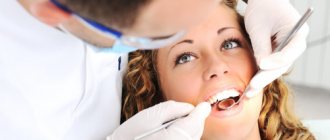Common reasons
Darkening of teeth can look different:
- If the discoloration is caused by plaque that is not properly removed, the color of the dentition appears uneven, darker at the base and lighter towards the edges; Possible causes are abuse of coffee and tea (strongly brewed drinks have a powerful coloring effect) and smoking. It is very difficult for tea, coffee and nicotine lovers to maintain a snow-white smile; they practically have to choose between beautiful teeth and established habits.
- If one or more teeth have a pronounced color difference, we have to talk about poor-quality canal treatment or the development of secondary caries (after removal of the nerve, the darkening of the tooth is explained by the lack of nutrition and is natural; a dark rim around the filling is a signal for its immediate replacement due to a violation of the tightness ). A tooth can also be darkened by trauma that causes nerve death or internal bleeding; whiteness can only be restored through careful treatment of the canals, sometimes with intracanal bleaching.
Black plaque is not only a death sentence for a smile, but also a possible cause of caries. Only regular visits to the dentist will help you avoid troubles and keep your teeth healthy and white.
The best specialists from France
François Najjar: French Dental Clinic.
Chief physician, founder of FDC
Since 2004, the doors of the first exclusive French Dental Clinic in Russia have been opened for everyone who wants to have an appointment with famous specialists from Paris, Nice, Cannes, Sophia Antipolis, Lyon, Lille.
Specialists from all areas of dentistry were invited from different parts of France in order to undergo the most stringent selection. The choice fell on professionals with extensive experience of successful work and excellent recommendations.
— French Dental Clinic team
Frank Ajege
Periodontist-implantologist
Experience in surgical dentistry since 1987. Has a private clinic in Nice (France).
Michel Cassagne
Orthodontist
with over 30 years of experience in dentistry. Has a clinic in Paris, specializing in aesthetic orthodontics.
Didier Saada
Dentist
Experience in dentistry since 1988. Graduated from the Faculty of Surgical Dentistry at the Medical University in Marseille.
Why do children's teeth turn black?
While many explanations can be found for the darkening of tooth enamel in adults, black teeth in a child cause bewilderment and confusion among parents. In fact, a child’s teeth can darken even with careful hygiene and in the absence of chronic diseases.
There are several reasons for the problem, the main one is improper nutrition with the amount of sweets in the diet: microbes, like people, love sweets, the effect of sweet food on tooth enamel is negative, associated with the appearance of a dense microbial biofilm. Other common reasons:
- genetic predisposition
- calcium deficiency
- dysbacteriosis
- early caries
If you notice dark gingival stripes on your child’s teeth, do not ignore them: the appearance of the so-called Priestley’s plaque is one of the consequences of the development of the digestive system, which resolves itself with age, but it is better to clarify the diagnosis with a dentist. Dark spots and dots on the baby’s teeth should also cause concern: contrary to the popular belief that baby teeth should not be treated, in the absence of adequate treatment, permanent ones that grow to replace them are often damaged.
Black teeth in a child are an alarming signal that requires an immediate preventive examination by a dentist, since all pathologies develop rapidly in childhood.
Symptoms of tooth decay under the crown
The first sign of an inflammatory process under a prosthesis is not pain, as many people think, but an unpleasant odor. This happens because at the stage of preparation for prosthetics, the tooth is usually depulped, that is, the neurovascular bundle, which is responsible for sensitivity, is removed.
- An unpleasant taste first appears in the mouth, then a putrid odor is added, which cannot be masked by any chewing gum or mouthwash.
- The patient discovers a gap between the crown and the gum, where food debris gets in, which becomes a breeding ground for microbes.
- Often, inflammation of the gums develops near the tooth with the formation of soft tissue swelling.
- If the tooth has not been pulped, then severe pain is present.
- Blackening of the tooth under the crown.
All these symptoms indicate an advanced putrefactive process in the tooth covered with a crown. You should immediately seek medical help from a dentist.
Ignoring the problem leads to dire consequences:
- formation of a purulent cyst at the apex of the root;
- complete tooth destruction;
- the formation of periostitis or gumboil;
- spread of purulent infection along with blood or lymph flow to other organs.
Black teeth: treatment methods
What can you do at home?
It is well known that you can make your teeth lighter by quitting smoking and limiting your consumption of coloring drinks such as strong coffee and tea.
Another obvious requirement is regular brushing of teeth with the addition of additional dental hygiene products (dental floss, rinses, etc.)
On the Internet you can find many recommendations for changing the shade of tooth enamel using folk remedies, but you should not rely on such solutions, since only professional hygiene and whitening give real results. Don't self-medicate!
If you decide to see a dentist
At the first appointment, provide the specialist with as much information as possible about your health, lifestyle and bad habits - this will help the dentist quickly and accurately stop the cause of the pathology.
If the darkening is due to tooth decay, recent nerve removal, or other dental problems, treatment will be required. Today, dentistry fights for every tooth, offering solutions even in situations that seem hopeless, including restoring teeth with crowns or veneers.
The method of treatment is selected individually based on the general condition of the oral cavity.
Factors that affect the color of teeth.
Nutrition and lifestyle have a significant impact on the color of tooth enamel. Drinking strong tea, coffee, cigarettes, and certain fruits are direct culprits in the process of teeth darkening. However, these are the most famous culprits of darkening; besides them, there are many others. The list of products that cause darkening of enamel is much longer. This includes chocolate, red wine, blueberries, soy sauce and so on.
All products that contain dyes, iron and sugar can be safely classified as causing darkening of teeth.
You can’t ignore carbonated drinks, because in most cases they contain various dyes, and this is a direct path to darkening the enamel. Ordinary colorless mineral water, it would seem, should not affect the color of teeth, but if it contains a lot of iron, the teeth will darken.
What is the way out of this situation, how to protect your smile and protect it from darkening?
Give up many foods, stop eating food and drinks? It sounds ridiculous, not to mention the implementation of such an ambitious and unrealistic plan. In addition to foods, the color of teeth can be influenced by a completely different, internal factor, possibly dental disease.
Making a diagnosis yourself and self-medicating, trying out a variety of whitening products and techniques - like playing Russian roulette, can help, but it can also harm. Therefore, no one other than a qualified dentist can determine the exact cause of teeth darkening.
There have been cases when people tried to whiten their teeth using abrasives, mechanical cleaning and ultimately destroyed tooth enamel. Someone, having seen enough advertising for chewing gum with a whitening effect, began to diligently use them and received nothing but harm to the stomach in return. Gastric juice is released abundantly during chewing and begins to digest the walls of the stomach itself, and this does not bode well. Loss of health, but still no snow-white smile. That is why you should never listen to the advice of friends.
The answer to the question: “why are teeth darkened” can only be given by an experienced dentist, and only he can tell you about effective ways to combat this problem.
It must be said that French Dental Clinic never approaches the patient formally. By visiting our clinic, you will appreciate the most active participation in your health. Upon completion of the procedures, you will receive a guarantee for the treatment performed. Contact us and see for yourself.
Healthy teeth and good health
FDC will be a pleasant find for you and your family on the path to impeccable aesthetics and good health.
Methods for treating black teeth
- If black streaks or stains appear on the teeth due to improper care, professional hygiene is prescribed. In our clinic you can sign up for a “denticure”, your teeth will be free of plaque, and your smile will be attractive again
- If your teeth are blackened due to food dyes, then professional or home whitening, using special toothpastes and eliminating coloring foods from your daily menu will help.
- If your teeth have turned black due to caries, then sanitation with further restoration of the tooth and preventive procedures to strengthen your teeth are necessary. No dentist will remove black teeth without understanding the cause.
Provide thorough and competent oral care - and you will never know what black plaque is. See a dental hygienist to learn how to properly brush your teeth and choose a toothbrush and toothpaste.
The main reasons why a tooth under a crown begins to smell bad
Wearing a prosthesis longer than expected . Over time, when wearing a denture for a long time, the gum tissue atrophies, and the area of the neck of the tooth is exposed. A loose connection of the crown to the gum causes the formation of a gap into which food debris gets trapped. It is impossible to remove accumulated substrate from under the crown using traditional methods: toothbrush, rinsing. As a result, an environment favorable for the growth of bacteria is formed under the crown, which in the course of their life emit foul-smelling sulfur dioxide gases.
Violation of the seal between the crown and the tooth . The reason is most often the incorrect installation of the prosthesis or the resorption of the material that was used to fix the artificial crown to the supporting tooth. Pathogenic microflora, penetrating into the formed cavities, causes secondary caries and inflammation of the gums.
If the crown is metal-ceramic, then under the influence of salivary secretions and oxygen in the air, the metal in its composition undergoes oxidation, which causes an unpleasant odor. In addition, the resulting oxides irritate the mucous membranes of the gums and can provoke allergic reactions.
Lack of tooth protection after grinding . One of the stages of preparation for prosthetics is preparation - removal of the enamel coating, which protects tooth tissue from mechanical damage and the action of microbes. If, before installing a permanent prosthesis, the ground tooth is not covered with a temporary crown or treated with cement, then bacteria settle on it and continue their destructive activity under the prosthesis.
Violation of the technological process of manufacturing and installing a prosthesis . If a crown is installed incorrectly, regardless of the reason (insufficient experience of dental technicians and orthopedists, use of low-quality materials), soft tissue injury occurs, followed by infection and the development of inflammation.
Poor oral hygiene . Artificial structures - dentures require special care and cleaning. If you neglect the rules of hygiene, pathogenic microorganisms begin to actively multiply, causing putrefactive processes.
Poor quality dental treatment . One of the main conditions for successful prosthetics is the absence of infection in the oral cavity. If teeth that are subject to prosthetics have a defect in filling the dental canals, a granuloma or cyst filled with pus may form at the apex of the root.
When teeth affected by caries appear under the crown, the decay process continues and ends with complete destruction and death of the tooth.
Professional dental care
Treatment of blackening of teeth near the gums in the dental office includes several stages:
- Elimination of the reasons that provoked the color change.
- Bleaching.
If the surface of the tooth near the gum has turned black due to the presence of cervical caries, measures must be taken to eliminate it. Treatment options for blackening will depend on the stage of enamel damage:
- At the black spot stage, remineralizing therapy is used: the tooth surface is cleaned of plaque and stone, and applications with fluoride-containing compounds are applied to the affected area.
- At the stage of superficial caries, the affected area is polished and eliminated.
- In case of average caries, the damaged part of the tooth is removed, the area is treated with a special preparation and a filling is installed.
- In case of deep caries, the pulp is removed and the canals are cleaned, after which a filling is installed.
If the tooth turns black at the gum due to tartar deposits, the affected areas are cleaned using one of the selected methods:
- mechanical – manual method using special tools;
- chemical - removal of solid deposits using compounds based on alkalis and acids;
- ultrasonic cleaning – devices that emit sound waves are used to clean enamel;
- laser – removal of tartar with a laser.
The teeth whitening procedure is the final stage of cleansing the enamel from darkened plaque. For this purpose use:
- laser installations;
- ultrasound;
- chemical compositions;
- special lamps.











